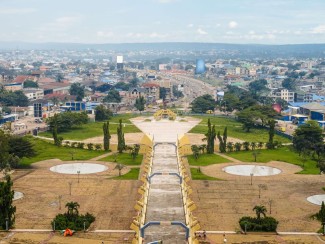Cambodia Impact Story. Explore more impact stories here.
KEY RESULTS
- Cambodia’s rice exports have increased exponentially, with the contribution of support from the Enhanced Integrated Framework (EIF) and partners. The value of rice shipments increased by 200% from 2011 to 2015, and rice export markets grew from 35 to 83 destinations during the same period.
- The EIF-supported National Silk Strategy, as part of the Government’s initiative to strengthen the sector, significantly contributed to increased production and exports of silk products. This raised the average monthly incomes of silk weavers, who are mainly women, from USD 472 in 2012 to USD 909 by the end of the project period in 2014.
- EIF support to Cambodia’s rice and silk sectors, and the Academy of Culinary Arts Cambodia (ACAC), has shown sustainability post the project’s lifespan. This is evident both in terms of diversification of markets and the building of beneficiaries’ economic resilience through job creation.
- There is a growing demand, especially post-COVID-19 restrictions, from international hotel chains and restaurants for graduates from the ACAC supported by the EIF and the Swedish International Development Cooperation Agency. This institution was inaugurated in 2017 in response to the Royal Government of Cambodia’s identification of tourism as a leading source of employment and economic growth.
- The EIF National Implementation Unit (NIU)’s capacity has grown through "learning by doing". By 2023 it was managing an International Fund for Agricultural Development project worth USD 63 million, among other projects, up from a total of USD 1.5 million worth of support when it first became operational.
Phenomenal growth achieved over the last decade saw Cambodia achieving new heights. Trade played an important part by bringing all line ministries and partners together under a concerted trade roadmap, the Trade Sector‑Wide Approach (Trade SWAp). Aimed at achieving sustainability and pro-poor trade growth, the Trade SWAp was introduced back in 2007 through the country's second Diagnostic Trade Integration Study (DTIS). It was later complemented by the Cambodia Trade SWAp’s Road Map 2014-2018 and its 20 Strategic Outcomes, developed and implemented in line with Cambodia’s Vision 2015, "Growth, Employment, Equity and Efficiency: Building the Foundation Towards Realizing the Cambodia Vision 2050", and the Royal Government of Cambodia’s 2030 Agenda for Sustainable Development.
One clear goal has been to use trade expansion to create better jobs, with higher skills that generate greater income, reach all parts of the country and consider the future prospects of the hundreds of thousands of youths entering the job market each year.
Cutting a unique and rewarding path to steady and sustainable growth
A journey that began in 2001 with Cambodia’s first EIF-supported Cambodia Trade Integration Study (CTIS) — as on the first three Integrated Framework DTIS pilot countries, alongside Madagascar and Mauritania — continues to date with the EIF’s partnership with the Royal Government of Cambodia. The country has revised and updated its EIF-supported CTIS on a regular basis in line with the term of each successive government, to identify existing and emerging obstacles, opportunities to further progress, and ways of overcoming challenges to build on and enhance its pro-poor trade agenda and implementation.
The CTIS 2019-2023, the fourth of its kind, was a milestone achievement where the Government fully led and owned the process. Here, it demonstrated growth of national capacity to undertake comprehensive analysis and develop a detailed implementation plan from start to finish. The inaugural DTIS was overseen by the World Bank, whereas the CTIS of 2007 and CTIS Update 2014 were conducted collaboratively under the leadership of the Ministry of Commerce and the United Nations Development Programme (UNDP).
EIF support further enabled the country to mainstream trade into its national development strategies and plans and promoted export diversification and expansion. Most prominently, the Trade SWAp was developed as the backbone of an ambitious cross-cutting trade strategy. It combines sector-specific reforms for product and service sector development, cross-cutting trade development issues, and capacity-building for trade development and its management. The Trade SWAp also provides the Ministry of Commerce and other trade-related line ministries with the tools to improve its coordination and overall management of Aid for Trade, as well as to monitor and review progress against targets.
Through the partnership with the EIF, the Ministry of Commerce strengthened the capacity of the Department of International Cooperation (DICO) as the main and permanent NIU, acting as the entry point for managing and mobilizing all externally funded projects under the Ministry of Commerce. This followed the development of the Medium-Term Programme for Aid-for-Trade 2016-2021 and the organization of a pledging roundtable in March 2016. By 2023, the DICO had 30 staff across four units – resource mobilization, aid management, monitoring, evaluation and communications, and administration and training. Over the years, the DICO’s capacity has grown from managing USD 1.5 million from the EIF to managing a USD 63 million International Fund for Agricultural Development (IFAD) project without external project management support. But it doesn't stop there. In addition to managing EIF‑ and IFAD-supported projects, the DICO has collaboratively implemented initiatives and provided technical assistance alongside other in-country development partners. Examples include the Arise Plus Cambodia Project, funded by the European Union and German BMZ at EUR 9.5 million, and a USD 1.1 million project with Swisscontact under the Global Alliance for Trade Facilitation. Moreover, the DICO has partnered with the Asian Development Bank on three technical assistance initiatives — Rules of Origin, Trade Remedy and Secured Transactions.
Better export products building better jobs and lives
The Royal Government of Cambodia’s vision of "Growth, Employment, Equity and Efficiency" sought to build better jobs and quality exports, to bring in better incomes to improve the quality of life for its population. The EIF supported five priority areas out of the 10 identified in the CTIS: milled rice, high-value silk, fisheries, cassava and hospitality, which, with limited resources, could enable sustainable development using pro-poor trade as an engine for growth as a proof of concept.
The Government and the EIF saw rice, Cambodia’s largest employment sector, as providing an opportunity to increase exports of milled rice to improve the incomes of many rice farmers and millers. The EIF funded the 2012-2016 project that contributed towards a bigger European Union‑funded agriculture programme in Cambodia. The partnership between the Government and the EIF contributed to a sector-wide Cambodian Milled Rice Standard, the establishment of the Cambodian Rice Federation, a sustainable export strategy and export production portfolio, and a Cambodian rice brand, with production boosted by an increase in the land area used to plant aromatic rice.
The International Finance Corporation partnered as the main implementing agency on the project, introducing food safety standards management principles, advice on equipment and technology upgrades, and improved rice mill management through the introduction of mill software and financial literacy training. The rice export sector established working groups such as the Export Promotion Working Group and the Global Market Access Executive Committee Working Group to support the Government in meeting targets for milled rice exports.
Academic project partners – the Royal University of Agriculture, the University of Battambang and Kampong Cham National School of Agriculture – updated their food safety curricula to meet food safety standards and food industry needs. The partnership is creating a sustainable core of graduates specialized in food safety to support the expanding agricultural industry sector.
Cambodian rice now meets standard and hygiene requirements for export to most international markets. The country also won the world’s best rice award three years in a row, and the DNA fingerprint of Cambodia fragrant rice varieties was established. Specifically, the DNA fingerprint of the Cambodian brown rice variety, Somaly, was established as a benchmark against which rice (DNA) purity can be analysed.
Of the USD 72,5 million of rice exports in 2015 linked to the project, fragrant rice accounted for more than half, with 12 rice millers (from a target of 8) benefitting from the project. Over the project’s three-year implementation, the value of rice exports was nearly USD 147 million, and from its conclusion in December 2015, this figure rose to USD 450 million by 2020.
From 2011 to 2015, Cambodian rice exporters diversified their markets from 35 to 83 destinations through EIF-facilitated participation in international trade fairs, conferences, and other events. This increased the value of their rice shipments by almost 200%.
Fair and ethical silk product exports bring gains for women
According to the International Trade Centre (ITC), the number of silk weavers in Cambodia was estimated to be between 18,000 to 20,000 in 2016, with over 90% of them being women. A 2012-2016 EIF-supported project, with ITC as the main implementing partner, sought to strengthen silk producers’ ability to develop a high-value product for export to new markets. This would also create jobs for women in rural areas. The pilot project, with a total budget of about USD 1.2 million – including USD 1 million from the EIF, USD 167,400 from The Royal Government of Cambodia, and USD 40,000 from private sector partners – was developed jointly with silk stakeholders, the Ministry of Commerce and ITC.
The project aimed to enhance the technical skills of weavers and marketing to diversify supply channels and export silk products. Its focus was on fair and ethical businesses working directly with rural women, from sericulture to production for export. Products included scarves, blouses, fashion accessories, jewellery, bags, cosmetic cases, toys and cushions. The project helped producers identify markets through participation in trade fairs and by establishing direct business contacts with buyers and importers.
The partnership developed a Cambodian Silk Sector Strategy (CSSS) with a gender-inclusive perspective and finalized a roadmap for its implementation under the leadership of the Silk Sector Development and Promotion Commission. The Strategy provided a five-year plan to achieve, by 2020, "a modernized silk sector producing high-value products providing sustainable income for women and men".
The Cambodia Silk Sector Development and Promotion Commission (SDC) was also created under the project as a permanent country-owned institutional mechanism composed of public and private stakeholders. Private sector associations, such as Cambodia Community Crafts, the Artisans Association of Cambodia, the Cambodia Women Entrepreneurs Association and Khmer Silk Village, were involved in the update of the CSSS as members of the SDC.
There was a 92% increase in weavers’ monthly average income from silk weaving, from an average of USD 472 in 2012 to USD 909 in 2014 per weaver. In the same period, supported companies increased the number of weavers under contract by 20%, with women making up 75% of the total.
Companies also benefitted from individual coaching, advisory support, and training to develop their products and markets. Contacts were established with more than 300 prospective buyers in Europe, the United States, Japan, Australia, and New Zealand. Craft Village – one of the project beneficiaries – which has been diversifying its products while maintaining the weaving tradition and creating jobs for women weavers, increased export sales by 16% and overall sales by 57%. According to the Craft Village CEO, Naiseng Lang, the number of buyers increased from 5 to 25, and the number of contracted weavers increased from 2 to 15. One small/medium-sized enterprise (SME) successfully registered as a Guaranteed Fair Trade Organization with the World Fair Trade Organization.
Securing youth employment prospects in tourism and hospitality
The ACAC was established as a public–private partnership, supported by the EIF and the Government of Sweden, in response to the Royal Government of Cambodia’s identification of tourism as a leading source of employment and economic growth. It is the first chef’s school in the country to offer an internationally recognized diploma focusing on the higher levels of sous chefs and head chefs. Established in 2017, it has since trained 436 students, and there is growing demand for ACAC graduates from international hotel chains and restaurants.
A key feature of the Academy is its ongoing funding base post-EIF: a mix of government budget, support from the private sector and student tuition fees. The Academy has a partnership agreement with the Swiss Hotel Management School in Lucerne, where selected students can go for additional skills development.
E-commerce ready
In 2020, the EIF supported the Ministry of Commerce and other key ministries to increase economic opportunities for micro-, small- and medium-sized enterprises (MSMEs)' participation in the global marketplace through e-commerce.
Following on from the 2017 eTrade Readiness Assessment, supported and implemented by the Royal Government of Cambodia and the United Nations Conference on Trade and Development, the EIF-supported project for MSMEs resulted in the launch of a digital marketplace for business-to-business and business-to-consumer cross-border trade. The platform has integrated local banks and fintech firms to provide solutions for cross-border payments. The Cambodia Post and courier company DHL Cambodia have been included in the project to ready their infrastructure for deliveries.
Of 558 applicants, 160 MSMEs have been approved to onboard on the CambodiaTrade.com platform, representing more than 5,000 jobs of which more than 50% are occupied by women. Half of these enterprises are female-owned, and 44% are based in rural areas.
Collectively, there are now more than 1,415 "Made in Cambodia" products listed on the platform, which was officially launched on 31 March 2022, and targeting annual sales of at least USD 2 million. The USD 1.69 million funding from the EIF and additional support from Australia, UNDP Cambodia and Khmer Enterprise (a private sector company) also supported an incubation programme and innovation challenge for MSMEs. This included a boot camp and small grants to selected businesses to improve their e-commerce prospects.
Part of the work was to standardize key documents so that all buyers and sellers have a shared understanding of the rules. An e-commerce strategy was developed in 2020, and an e-commerce law was passed by the national legislature to ease the registration of e-commerce businesses. The Government has also reduced the cost of registration by 40% to make it more affordable for startups to enter the marketplace.
A long-term perspective
Cambodia’s long-term perspective on inclusive growth through trade – which promotes the quality of life for its citizens today and in the future, while building resilience along the way – is a special one. Also key has been the recognition that this is best achieved when everyone has a seat at the table, sharing a common goal and providing continuity based on "do‑it‑yourself" learning.
The country has established and strengthened partnerships from the grassroots level to the private sector across the spectrum, and ensured that all relevant government ministries have a part to play and share a common vision. Over the course of its partnership with the EIF, the Government has demonstrated links with 159 private sector enterprises, agricultural and tourism associations, the Chamber of Commerce, information communication technology companies, the banking sector, academia, and non-governmental organizations, among others. It has implemented activities on the ground across the country, supporting over 1,000 SMEs, building confidence, skills, and improving livelihoods. At the government level, a home-grown approach and capacity development have built skills to develop and implement projects effectively.
_ _ _
As the second phase of the Enhanced Integrated Framework (EIF) comes to an end in 2024, the objective is to produce a catalogue of impact stories showcasing the efforts of the EIF partnership in the least developed countries (LDCs) and recently graduated LDCs where it has been actively engaged. This impact story makes up one of the stories in the catalogue. Essential input and reviews were received from the country‑based EIF National Implementation Units (NIUs) and the wider EIF team.
The primary objective of each impact story, as well as the entire catalogue, is to adopt a journalistic approach in recounting the EIF's engagement in the LDCs during both Phase One and Two. The aim is to offer valuable insights and to document outcomes and impacts, as well as some lessons learned from the work of the EIF partnership in the LDCs. These stories do not provide a comprehensive overview of every aspect of EIF partnership engagement such as precise timelines or the exact extent of involvement (i.e., financial contributions). Instead, they serve as one of several means of information about the work of the EIF partnership. Interested readers are encouraged to supplement these impact stories by consulting other sources, including EIF Annual Reports, Trade for Development News articles, EIF social media channels, and, where applicable, the NIUs in the LDCs as well as the EIF Executive Secretariat.
It is essential to acknowledge that the information provided is neither exhaustive (e.g., it is based on the latest available data at the time of writing in 2023) nor evaluative in nature.
Lastly, while each impact story adheres to a similar structure, the diverse range of countries, contexts, and EIF engagements means that each story is unique.
If you would like to reuse any material published here, please let us know by sending an email to EIF Communications: eifcommunications@wto.org.



